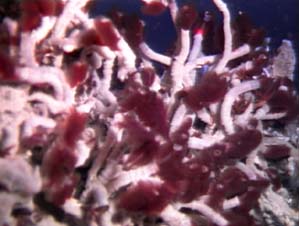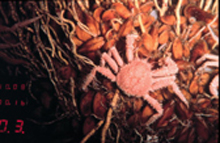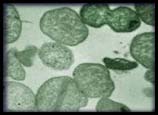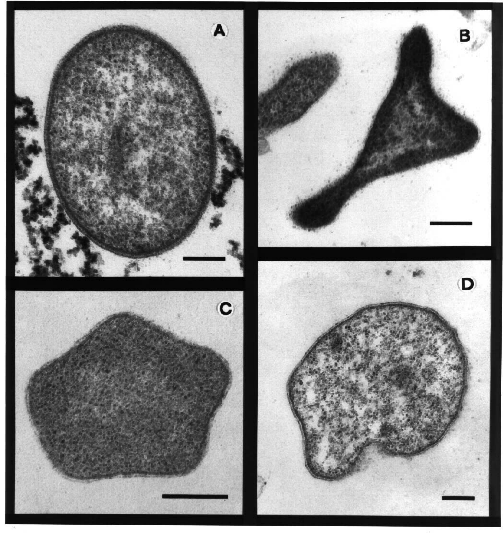
Introduction to Vent Biology
What kind of things live around the Edmond Vent System?
The Edmond Vent System is home to a variety of very distinct creatures. Because of the extreme depth, darkness, and pressure, ordinary marine species do not reside in the abyssal environment. Those critters that do live in the mysterious fathoms below have made intriguing adaptations to the ecosystem around them.
|
Tubeworm
Perhaps the most well known inhabitant of the hydrothermal vent environment is the tubeworm. Reaching lengths of up to two meters, they dwarf the tubeworms living near the surface. They are intriguing animals. Having neither a mouth nor a stomach, they depend on the symbiotic bacteria living within them to make sugars from the vent excretions. Tubeworms are usually the first inhabitants in a new vent community. |
Shrimp, Crab and Mussels
Other creatures include the shrimp that live around the Edmond Vent system feed on microbes that reside in and near the hydrothermal vents. They gather in huge groups to feed on the microbes and also mussels. Crabs living near hydrothermal vents aren't similar to the crabs found near the surface. They are colorless and small and live around the mussels and feed on them, bacteria, tubeworms, and each other. Mussels live around the hydrothermal vents. They capitalize, like the tubeworm, on the sugar produced by microbes living in their gills for energy. |
Microbes
Some of the most interesting creatures living in the Edmond Vent are the smallest. Microbes of multiple species reside in the vents. They live on all surfaces down there, and can also live in the water column. The microbes are chemo-autotrophic which means they harvest energy from the chemicals coming from the vents. They metabolize hydrogen, hydrogen sulfide, and even iron. They turn these substances into sugar and carbon dioxide. The thermophilic bacteria have enzymes that function at extremely high temperatures and pressures. |
Archaea
Archaea are a relatively newly discovered inhabitant of the vents. Archaea are simple cells that don't have nuclei. They resemble microbes somewhat, but are mysteriously different. Their genetic makeup is unlike that of any creature we have seen to date. Scientists don't know too much about archaea and so of course we yearn to know more! Perhaps the secrets from the strange species at the bottom of the ocean can help us to understand our own existence on the surface of the earth. |
Continue to Introduction to Vent Geology
Resources
1. Tubeworm picture: http://www.divediscover.whoi.edu/about.html
2. Tubeworm and Tubeworm/Crab photo: http://www.pmel.noaa.gov/vents/nemo/education/curr_p1_12.html
3. Crab picture: http://sustainableseas.noaa.gov/aboutsse/liveevents/images/ventcrab.jpg
4. Microbe photo: http://www.pmel.noaa.gov/vents/nemo/education/curr_p1_11.html
5. Archea picture: http://newport.pmel.noaa.gov/nemo1999/images/bugtem.gif




